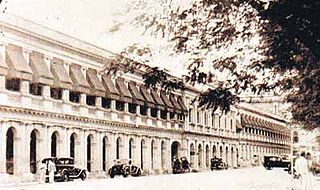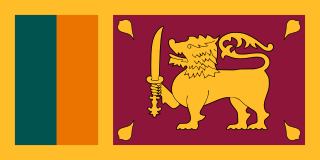Related Research Articles

The Parliament of the Democratic Socialist Republic of Sri Lanka is the supreme legislative body of Sri Lanka. It alone possesses legislative supremacy and thereby ultimate power over all other political bodies in the island. It is modeled after the British Parliament. The 17th Parliament of Sri Lanka will convene for the first time on 21 November 2024.

The State Council of Ceylon was the unicameral legislature for Ceylon, established in 1931 by the Donoughmore Constitution. The State Council gave universal adult franchise to the people of the colony for the first time. It replaced the Legislative Council of Ceylon, the colony's original legislative body.

Sir Oliver Ernest Goonetilleke was a Sri Lankan statesman. Having served as an important figure in the gradual independence of Ceylon from Britain, he became the third Governor-General of Ceylon (1954–1962). He was the first Ceylonese individual to hold the vice-regal post.
The Ceylon Civil Service, popularly known by its acronym CCS, was the premier civil service of the Government of Ceylon under British colonial rule and in the immediate post-independence period. Established in 1833, it functioned as part of the executive administration of the country to various degrees until Ceylon gained self-rule in 1948. Until it was abolished on 1 May 1963 it functioned as the permanent bureaucracy or secretariat of Crown employees that assisted the Government of Ceylon.
In Sri Lanka, the Cabinet of Ministers is the council of senior ministers responsible and answerable to the Parliament of Sri Lanka. The President is a member of the cabinet and its head.

The Legislative Council of Ceylon was the legislative body of Ceylon established in 1833, along with the Executive Council of Ceylon, on the recommendations of the Colebrooke-Cameron Commission. It was the first form of representative government in the island. The 1931 Donoughmore Constitution replaced the Legislative Council with the State Council of Ceylon.
The Executive Council of Ceylon was the executive council created in Ceylon by the British colonial administration on the recommendations of the Colebrooke-Cameron Commission along with the Legislative Council of Ceylon in March 1833.
The Ministry of Finance, Economic Stabilization and National Policies is a cabinet ministry of the Government of Sri Lanka responsible for developing and executing the government's public finance policy, economic policy and long term fiscal planning. The Treasury is housed at the General Treasury Building in Fort.

The Minister of Finance is an appointment in the Cabinet of Sri Lanka. The post was created in 1947 when Ceylon gained independence as Sri Lanka.

The prime minister of Sri Lanka, officially the prime minister of the Democratic Socialist Republic of Sri Lanka is the most senior member of parliament in the cabinet of ministers. It is the second-most powerful position in Sri Lanka's executive branch behind the president, who is the constitutional chief executive. The Cabinet is collectively held accountable to parliament for their policies and actions. The powers and functions of the Prime Minister has changed several times since the creation of the office in 1947.
The Minister Justice, Public Administration, Provincial Councils, Local Government and Labour is an appointment in the Cabinet of Sri Lanka.
John Gladstone Rajakulendran was a Ceylon Tamil politician and teacher.

Dewan Bahadur Chevalier Ignatius Xavier Pereira was a colonial-era Ceylonese businessman and politician.
Colonel Oswald Boyd Forbes was a tea-broker, military officer and politician in Colonial Ceylon.
The chief secretary of Ceylon, was the chairman and one of three officers of state of the Board of Ministers of the State Council of Ceylon from 1932 to 1947. The post succeeded that of Colonial Secretary which was one of six offices that held a seat in the Executive Council of Ceylon until 1932.
Leslie Simon Bernard Perera, CCS was a Sri Lankan civil servant. A career officer of the Ceylon Civil Service, he was the Permanent Secretary of the Ministry of Health and the Ministry of Cultural Affairs and Social Services as Director Civil Aviation, he played a major role in the formation of Air Ceylon. Later he served as High Commissioners of Sri Lanka to Canada.
The Legal Secretary of Ceylon, was an officer of state of the British Colonial Administration of Ceylon from 1931 to 1947, appointed from the Colonial Legal Service. The Legal Secretary one of three officers of state of the Board of Ministers of the State Council of Ceylon, who serve as the legal advisor to the government; administration of justice; criminal prosecutions and civil proceeding on behalf of the crown; election to the State Council, drafting of legislature and the public trustee. The post was formed under recommendations of the Donoughmore Commission the post replaced the Attorney General as the chief legal advisor to the Governor, it was in turn replaced by the post of Minister of Justice in 1947 under the recommendations of the Soulbury Commission under the Ceylon Independence Act, 1947 and The Ceylon Orders in Council 1947.
References
- ↑ Wright, Arnold (1999). Twentieth Century Impressions of Ceylon. Asian Educational Services. ISBN 9788120613355 . Retrieved 22 March 2014.
- ↑ "1942 Ferguson's Ceylon Directory". Ferguson's Directory. Retrieved 30 July 2021.
- ↑ "Evolution of the Office of the Attorney General in Sri Lanka". attorneygeneral.gov.lk. Archived from the original on 30 July 2021. Retrieved 30 July 2021.
- ↑ "1942 Ferguson's Ceylon Directory". Ferguson's Directory. Retrieved 30 July 2021.
- ↑ Ferguson, John (1887). Ceylon in the "Jubilee Year". J. Haddon and Co. pp. 256-7.
- ↑ Ceylon: Its History, People, Commerce, Industries and Resources. Plâté limited. 1924. p. 103. Retrieved 27 April 2016.